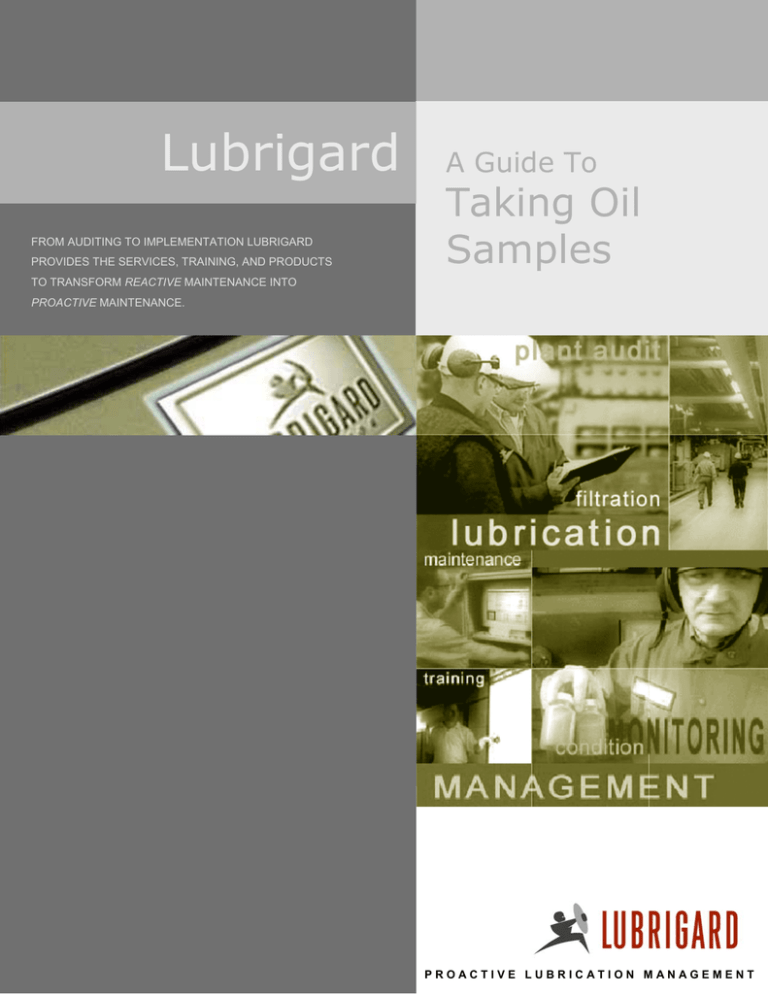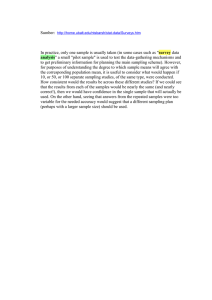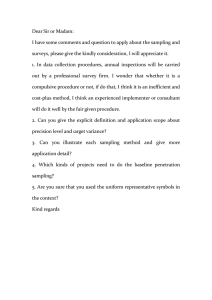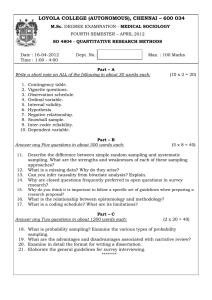
Lubrigard
FROM AUDITING TO IMPLEMENTATION LUBRIGARD
PROVIDES THE SERVICES, TRAINING, AND PRODUCTS
A Guide To
Taking Oil
Samples
TO TRANSFORM REACTIVE MAINTENANCE INTO
PROACTIVE MAINTENANCE.
PROACTIVE LUBRICATION MANAGEMENT
A Guide to
Taking Oil Samples
TABLE OF CONTENTS
What is the Goal of Taking Oil Samples? ….……………. 1
Why do I need to take Representative Oil Samples?…. 2
An Overview of Sampling Ports………………....…………….. 3
An Overview of Sampling Probes …………………………… 4
An Overview of Pitot Tubes ………………………..………….. 5
The Advantage of using Pitot Tubes ……………………….. 6
An Overview of Valve Mounts …………………..…………….. 7
Installing Valve Mounts …………………………………………. 8
Sampling Tips and Hardware Selection Guide….……….. 9
Sampling Hardware Order Form ………………………………. 10
CONTACT INFORMATION
Lubrigard Ltd.
C8 – 1175 Appleby Line
Oil Analysis is an essential part of any ConditionBased Monitoring (CBM) program, and forms the
foundation for a solid Lubrication Management
program. A successful oil analysis program begins
with proper oil sampling. Proper sampling involves
using the correct sampling ports and hardware,
installing this hardware in the proper location and the
use of proper sampling equipment and sampling
procedures. This guide is an overview of the sampling
process and provides helpful tips and suggestions for
taking oil samples correctly.
Bill Quesnel Jr.
Vice-President
Lubrigard Ltd.
Burlington, ON L7L 5H9
Telephone
905-569-8600
Toll-free
1-800-268-2131
Facsimile
905-569-8605
Web site
http://www.lubrigard.com
E-mail
info.sales@lubrigard.com
Lubrigard is a division of WearCheck Canada Inc.
© 2005-2007 Lubrigard Ltd. All Rights Reserved. All illustrations,
photographs and specifications within this literature are based on the latest
product information. All information contained on this literature is intended for
the Canadian market only. The information contained on this literature may be
changed at any time without prior notification or obligation. Lubrigard Ltd. makes
no representations as to the accuracy of this information. See actual product at
your Lubrigard Dealership for complete accuracy. Lubrigard Ltd. reserves the
right to make changes at any time, without notice, in prices, colours, materials,
equipment, specifications and models, and to discontinue models or equipment.
For information on additional options and accessories, contact your Lubrigard
Dealership. All product brand names are Lubrigard trademarks.
LG-SAMPLING-GUIDE-04-25-2008
A Guide to
Taking Oil Samples
What is the
Goal of Taking Oil Samples?
Understanding our goal when taking oil samples helps us understand
why proper sampling is vital to the process. Our goal when we take oil
samples is "to obtain a clear indication of the operating state of the
equipment".
In order to do this we need to ensure that the oil sample is
representative of the fluid in the system. Because we are collecting only
a small sample of the oil as compared to the volume of oil contained in
the system, then the sample we collect must accurately reflect all the oil
in the system. The sample must reflect accurately;
Contaminants present in the system
Additives present in the oil
Oxidation and degradation by-products in the oil
*Particulates present in the system
*Wear condition of components
The latter two conditions, particulates and wear, are especially sensitive
to the sampling process and in order for oil analysis testing to be truly
indicative of these conditions proper sampling is essential.
When specifying proper sampling for a system one has to consider the
fact that taking representative oil samples is dependant upon many
factors including;
The sample point location
The sampling hardware and apparatus
The sampling method or procedure
The frequency of the sampling
Recent maintenance activities
The remainder of this guide will examine
the first three of these factors, and provide
you with the fundamentals for assessing the
appropriate sampling hardware, appropriate
hardware location and sampling techniques.
We take oil
samples “to obtain
a clear indication
of the operating
state of the
equipment”.
1
A Guide to
Taking Oil Samples
Why do I need to take
Representative Oil Samples?
Of course the best way to get your oil analysis program off to a
good start is to utilize the proper sampling apparatus and to
install sampling ports in proper locations. Sometimes this is
easier said than done.
Lubrigard provides a variety of sampling ports and sampling
devices to ensure that you are provided with the proper
sampling hardware to match your needs. Lubrigard has the
knowledge to show you the proper sampling locations for all
your lubricated equipment.
Sampling from an improper location oftentimes leads to
incorrect oil analysis results. Don't waste time and money on
oil analysis testing, and end up reacting to phantom problems
with your oil. Installing proper sampling apparatus in the
correct location before undertaking an oil analysis program
ensures that samples are always taken from the same location
in the equipment and are representative of the circulating oil in
the equipment.
Don't waste time
and money on oil
analysis testing, and
end up reacting to
phantom problems
with your oil.
2
It is virtually impossible for an operator to take a nonrepresentative sample using proper equipment and ports. Oil
sampling is easier and takes less time when the appropriate
sampling apparatus is installed. A small investment in proper
sample ports will ensure that your oil analysis samples are
taken on time, in an efficient manner, that your samples are
truly representative of the condition of the oil and that your oil
analysis results are accurate and consistent.
A Guide to
Taking Oil Samples
An Overview of
Sampling Ports
Sampling ports are available in a variety of styles, which all offer a low cost
and simple way to achieve representative oil samples. Installation typically
involves the removal of an existing oil plug (on the pressure block, oil
galley, or drain plug for instance) and replacement with the sampling port.
As a result these ports come in a variety of standard thread sizes (NPT,
Metric, etc.). The key advantage is easy and representative sampling with
the use, in most cases, of a sampling probe (a simple hose and fitting).
Minimess (GP Series)
The minimess sample port (also known
as a gauge plug, or test point) is the
simplest and most common port in use
for sampling today. The minimess can
be installed on systems with pressures
up to 6000 PSI. Typical applications are
in industrial plants and include hydraulic
systems, compressors, and injection
moulding machines.
Push Style (KP Series)
The push-button sample port is suitable
for installations where the pressure at
the sampling point will not be greater
than 750 PSI. The nice feature of this
style of port is that you simply remove
the small screw-on cap and push the
button to create an oil flow for sampling.
Typical applications include engines,
compressors, and transmissions.
Probalyzer Style (KST Series)
The probalyzer style allows for sampling
with a standard sampling pump that
includes a probalyzer sampling port.
With such a pump, sampling simply
involves pushing the pump onto the port
to release the oil flow through the pump
into the sample bottle. Typical
applications include mobile, off-road,
and marine as these ports are good for
sampling systems at up to 750 PSI.
Sampling ports
offer a low cost and
simple way of
achieving
representative oil
samples.
Flush Mount (L Series)
The flush mount ports are suited to
systems where a sample port could
easily be knocked off during operation
(such as a final drive), or where highviscosity fluids are encountered. As a
result these ports are used for off-road
applications, including final drives,
differentials and gearboxes.
3
A Guide to
Taking Oil Samples
An Overview of
Sampling Probes
All sample ports (with the exception of the KP series), pitot tubes and valve
mounts require a sampling probe (a sampling hose with adapter or
sampling pump with adapter) in order to draw oil samples. Sampling
pumps can be used in conjunction with sampling hoses to draw oil samples
from unpressurized systems, or simply to prevent contamination of the oil
sample during the sampling process.
High-Pressure Sampling Hose
(SHHP01)
This sampling hose is good for
sampling systems up to 6000 PSI
and readily connects to the GP
series sample ports, BT series pitot
tubes, and all valve mounts.
Low-Pressure Sampling Hose (SLF4)
This sampling hose is good for sampling
systems up to 75 PSI and readily
connects to the L series sample ports and
LT series pitot tubes.
All sample ports,
pitot tubes and
valve mounts
require a
sampling probe
to draw an oil
sample.
4
Vacuum Sample Pump (SP38)
The vacuum sample pump can be used with
all sampling hoses, and 3/16”, ¼” or 5/16”
plastic tubing and fits standard 38 mm
thread bottles (in use by most laboratories).
The sample pump can be used to draw oil
samples under vacuum, or simply to assist
in keeping the sample uncontaminated
during the sampling process.
Vacuum Sample Pump with
Probalyzer Adapter (SP38PR)
Similar to the standard vacuum sampling
pump, this sample pump can be used with
all standard tubing and hoses, however this
pump also includes a probalyzer port
adapter on the front of the pump suitable
for use with KST series sample ports.
A Guide to
Taking Oil Samples
An Overview of
Pitot Tubes
Pitot tubes (or tube extenders) are available in a variety of lengths and
styles, and are used primarily in gearbox applications. Installation involves
the removal of an existing port plug from the gearbox and insertion of the
pitot tube. All Pitot tubes have a standard ¼” NPT thread, but can be
bushed down to fit into the existing port hole. The variety of pitot tube
styles available allow for sampling directly into the oil reservoir, from above
or below the oil reservoir. All pitot tubes come in 12”, 18”, and 24”
lengths, but may be custom ordered for exact lengths or can be easily cut
to a specific length during installation.
Lo-Viscosity Fixed Pitot Tube (BT Series)
This is the most basic pitot tube available. These pitots utillize a
standard minimess sample port with a tube extender to allow for
insertion of the sample port directly into the gearbox oil reservoir.
Lo-Viscosity Swivel-Style Pitot Tube (BT Series with –S option)
Occasionally it is necessary to install the pitot tube from above the oil flow.
In this case it is necessary to bend the pitot tube (with a standard tube
bender tool) to allow the pitot tube to dip into the oil reservoir. The
swivel-style pitot tube comes with an integrated swivel adapter to allow for
the proper placement of the pitot tube after it has been bent.
Hi-Viscosity Pitot Tube (LT Series)
In all respects this series of pitot tube is similar to the BT Series. The
only difference is that this pitot tube employs an L series port which
makes it suitable for use with high viscosity oils (ISO 220 or greater).
A Pitot tube
provides the
optimal method
for sampling a
gearbox.
Hi-Viscosity Swivel-Style Pitot Tube (LT Series with –S option)
In all respects this series of pitot tube is similar to the BT Series with the
Swivel option. The only difference is that this pitot tube employs an L series
port which makes it suitable for use with high viscosity oils (ISO 220 or
greater).
5
A Guide to
Taking Oil Samples
The Advantage of Using
Pitot Tubes
The difficulty associated with the traditional sampling of gearboxes lies in
the fact that the gearbox would have to be shutdown, and a sample
obtained by removing the fill cap and then inserting a length of tubing
down past the gears into the reservoir and drawing the sample up with a
sample pump. This is a cumbersome procedure for sampling gearboxes,
and most individuals assigned the task of doing so are more apt to take
samples from just about any other place on the gearbox, such as in this
example where a drain pipe is utilized.
Sampling from Existing Drain Pipe
The problem with taking oil
samples in this manner is that
the oil taken for a sample is
the first oil out of the pipe
which is not representative of
the oil in the gearbox.
undoubtedly this oil is going to
contain rust, scale and water
which has settled to the
bottom of the tank. The end
result is an oil sample report
indicating a serious problem
where no problem may
actually exist.
Dead leg pipe used for draining
gearbox, contains settled dirt,
rust, scale and water.
Sampling from an Installed Pitot Tube
Sampling
gearboxes from
dead leg pipes
produces erratic
and misleading
oil analysis
results.
Pitot tube inserted into the gearbox
below the oil level.
Pitot Tube combined with Level
Gauge (LG3, LG6, LG9, LG12)
The Lubrigard level gauges allow you
to realize multiple usage from a single
sump port. The Lubrigard level gauges
are used in conjunction with either the
standard or high-viscosity pitot tubes
to allow for a single sump port to
accommodate both a sampling port
and level gauge.
Level gauges are available in 3”, 6”,
9” and 12” sizes.
6
In this case a gear plug has
been removed and a pitot tube
installed. When a sample is
taken, the operator simply
removes the dust cap, attaches
a sample hose (connected to
the sample pump) and draws
oil from the gearbox using the
vacuum from the sample pump.
In this manner consistent
samples are easily obtained
from this gearbox and are
representative of the oil
circulating in the gearbox.
A Guide to
Taking Oil Samples
An Overview of
Valve Mounts
Valve mounts are an ingenious way of getting around the conundrum of
sampling from the system return line. On pressurized systems with a
reservoir the recommendation is to sample from the return line. The irony
is that the return line is, in almost all instances, devoid of any ports, or an
easy place to install a sampling port. The Valve mount gets around this
problem by providing a way of installing a sampling port without a need for
a complex retrofit of the return line.
Valve Mount Pressurized Install
(VM1 Series)
The Pressurized Install style of the valve
mounts offer the ability to be installed
on oil lines with operating pressures up
to 6000 PSI while still in operation. This
allows for installation of the sampling
port without the need to shut-down
equipment. These valve mounts are
leak proof and offer a safe, permanent
mounting system. Once installed
sampling is conducted by using a hipressure sampling hose attached to the
integrated minimess sample port.
Valve Mount Unpressurized Install
(VM2 Series)
The Unpressurized Install style of the
valve mounts is in everyway similar to
the pressurized install valve mounts,
except that they do not possess the
ability to be installed on oil lines while
under pressure. These valve mounts
must be installed when the system is
shut-down, however, after installation
will withstand operating pressures up to
6000 PSI. These valve mounts are leak
proof and offer a safe, permanent
mounting system. Again, once installed
sampling is conducted by using a hipressure sampling hose attached to the
integrated minimess sample port.
The Valve Mount is
an ingenious way
of getting around
the conundrum of
sampling from the
system return line.
7
A Guide to
Taking Oil Samples
Installing
Valve Mounts
Pressurized Install
1
2
3
4
5
6
1. Pipe should be in good condition and
have the proper diameter. Do not use in
air or gas pipes. Pipe location should not
add extra stress or tension on the valve
mount.
2. Once you have removed paint and
cleaned the pipe so that the pipe is smooth,
clean and dry, clamp the valve mount to the
pipe.
3. Screw down clamp bolts
4. Using an open jawed wrench (without
extension), screw in head joint in clockwise
direction as far as it will go.
5. Using an open jawed wrench (without
extension), screw back head joint in
counter-clockwise direction.
6. The system is ready for use.
Unpressurized Install
1. Check to see that the line is pressureless
and the machine is shut off and locked out.
Pipe should be in good condition and have
the proper diameter. Do not use in air or
gas pipes. Pipe location should not add
extra stress or tension on the valve mount.
2. Once you have removed paint and
cleaned the pipe so that the pipe is smooth,
clean and dry, clamp the valve mount to the
pipe.
1
2
3
4
5
6
3. Screw down clamp bolts
4. Using an open jawed wrench (without
extension), screw in head joint in clockwise
direction as far as it will go.
5. Screw out the sampling valve and
remove the spring plug, needle and
pressure disk.
6. The sampling valve is screwed back in
and the system is ready for use.
8
A Guide to
Sampling Tips and
Taking Oil Samples
Hardware Selection Guide
General Sampling Tips
Do not let the sample bottle become dirty or contaminated
Ensure that you clean around the sampling area before
taking the sample.
Discharge a few ounces of fluid into a waste container
before taking the actual sample. This can be done into a
separate sample bottle that is used for each discharge.
Do not sample from the used filter or bottom of the system
pan or reservoir.
If you are sampling different system types then sample the
cleanest systems first, followed by the dirtiest systems
Hydraulic -> Transmission -> Engine -> Differential -> Planetary
If using disposable sample tubing use a new piece of tubing
for each component being sampled.
Replace the cap on the sample bottle and tighten firmly
immediately after taking the oil sample.
Place the unit id sticker on the bottle before beginning
sampling, or before taking the next sample.
Hardware Selection Guide
Industrial Systems
Sample
Device
< 750 PSI <
220 cSt
< 750 PSI
> 220 cSt
Mobile Systems
Power Train
(Final Drive,
etc.)
Sampling
Probe
Required
< 6000 PSI
Engine,
Transmission,
Hydraulic
Good
Good
SHHP01
Sample Ports
GP Series
Fair
KP Series
Good
Good
---
KST Series
Good
Good
SP38PR
Good
L Series
Good
SLF4
Pitot Tubes
BT Series
Good
SHHP01
BT-S Series
Good
SHHP01
LT Series
Good
SLF4
LT-S Series
Good
SLF4
Valve Mounts
VM1 Series
Good
SHHP01
VM2 Series
Good
SHHP01
9
Oil Sampling Hardware
ORDER FORM
Please complete this form and fax to 905-569-8605. You will be contacted to confirm final pricing including
applicable taxes and shipping methods and costs.
Sample Ports
GP18 [Minimess 1/8” NPT]
Price $19.95
Qty
KST18N [Probalyzer Style 1/8” NPT]
Price $22.20 Qty
GP14 [Minimess ¼” NPT]
Price $19.95
Qty
KST14N [Probalyzer Style ¼” NPT]
Price $22.20 Qty
KP18N [Push Style 1/8” NPT] Price $32.90
Qty
L14NC [Flush mount ¼” NPT]
Price $30.35 Qty
KP14N [Push Style ¼” NPT] Price $32.90
Qty
Sampling Probes
SHHP01 [Hi-pressure hose]
Price $19.95 Qty
SP38 [Vacuum pump]
Price $35.00 Qty
SHLP01 [Lo-pressure hose]
Price $9.95
SP38PR [Probalyzer Vacuum Pump]
Price $35.00 Qty
SLF4 [L Series sampling hose]
Price $32.60 Qty
PT33 [Sample tubing 3/16” OD]
Price $0.50/ft Qty
KPB4 [KST Series Probe]
Price $8.65
PT44 [Sample tubing ¼” OD]
Price $0.50/ft Qty
Qty
Qty
Pitot Tubes
B14NT12 [12”, ¼” NPT rigid]
Price $56.40 Qty
L14NT12 [12”, ¼” NPT rigid, hi-visc]
Price $53.15 Qty
B14NT24 [24”, ¼” NPT rigid]
Price $58.20 Qty
L14NT24 [24”, ¼” NPT rigid, hi-visc]
Price $54.90 Qty
B14NTS12 [12”, ¼” NPT swivel] Price $73.75 Qty
L14NTS12 [12”, ¼”
NPT
B14NTS24 [24”, ¼” NPT swivel] Price $75.50 Qty
L14NTS24 [24”, ¼”
NPT swivel,
swivel, hi-visc] Price $70.50 Qty
hi-visc] Price $72.35 Qty
Level Gauges
LG3 [3”] Price $43.65 Qty
LG6 [6”] Price $51.40 Qty
LG9 [9”] Price $55.25 Qty
LG12 [12”] Price $74.00 Qty
VM1-38 [3/8” pressurized]
Price $303.95 Qty
VM2-38 [3/8” pressureless]
Price $186.20 Qty
VM1-12 [1/2” pressurized]
Price $303.95 Qty
VM2-12 [1/2” pressureless]
Price $186.20 Qty
VM1-34 [3/4” pressurized]
Price $321.10 Qty
VM2-34 [3/4” pressureless]
Price $209.00 Qty
VM1-1 [1” pressurized]
Price $321.10 Qty
VM2-1 [1” pressureless]
Price $209.00 Qty
VM2-112 [1-1/2” pressureless]
Price $233.70 Qty
Valve Mounts
VM1-112 [1-1/2” pressurized] Price $334.40 Qty
Payment and Contact Information
Shipping Instructions
Ship Via
Pay by credit card
Name (as it appears on card)
Card Type
Mastercard
UPS
Visa
Amex
Expiry Date
Card Number
FedEx
Purolator
DHL
Other Carrier
Shipping Charges
or Purchase Order Number
Prepaid & Chg
Collect Acct#
Purchase Order Number
Company Name
If you would prefer to have Lubrigard
send a technical representative to
meet with you and discuss your needs
call 1-800-268-2131.
Would you like a representative to
contact you? Yes
No
Contact Name
Contact Phone
Fax
E-Mail Address
Address
City
PROACTIVE LUBRICATION MANAGEMENT
State/Prov
Zip/Postal
LG-SAMPLING-ORDER-CA-2008-04-25
Lubrigard Ltd. C8-1175 Appleby Line, Burlington, ON, L7L 5H9 Tel 905-569-8600 Toll-free 800-268-2131 Fax 905-569-8605 URL http://www.lubrigard.com





